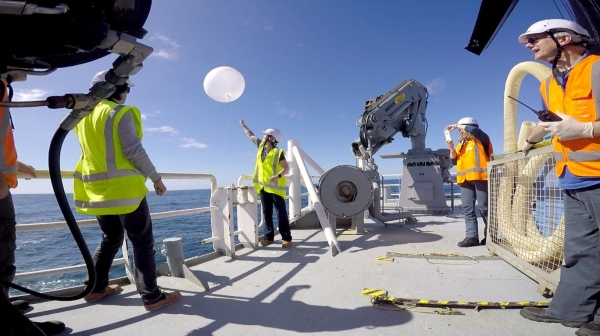Background
Clouds over the ocean, and how they trap or emit radiation from the sun, are partly influenced by the biology, biogeochemistry and physics of the surface ocean below.
Aerosols may be produced by sea spray and bubble bursting associated with breaking waves, while biogenic material carried in seaspray aerosols can also influence whether and how ice forms in the air above the ocean.
Furthermore, phytoplankton in the sea produce a range of compounds, including gases and particles, which when emitted to the atmosphere influence aerosol production. For instance, a long-standing theory, known as the CLAW hypothesis (acronym from first letter of hypothesis authors surnames: Charlson, Lovelock, Andreae and Warren), considers a biological mechanism for climate regulation: the production of sulphur compounds by phytoplankton and subsequent emission to the atmosphere results in oxidation to form sulphate aerosols and cloud condensation nuclei (CCN). These CCN provide the surface for water to condense upon and lead to cloud formation. This, in turn, is thought to reduce ambient light over the ocean and reduce phytoplankton activity.
The aim of the Sea2Cloud research project and associated 2020 voyage on RV Tangaroa was to find out more about these processes. The research, funded by the European Research Council and NIWA, is an endorsed research project of international SOLAS (Surface Ocean Lower Atmosphere Study).
2020 voyage and research
Building on previous ocean voyages, including Surface Ocean Aerosol Production (SOAP) in 2012, the Sea2Cloud voyage in February 2020 aimed to examine new particle formation processes, and the relationship between the biogeochemical composition of surface ocean and on primary aerosol production in differing water masses.
New Zealand provides an ideal location for carrying out this work due to different water types with different plankton within range of New Zealand, as well as a proven ability to carry out large scale measurement campaigns linking surface ocean and atmospheric processes through many previous ocean voyages.
There were months of preparation for the trip, which was jointly led by Cliff Law of NIWA and Karine Sellegri of the French National Centre for Scientific Research. The research involves collaborators from across the globe. It involved loading, setting up and calibrating a range of complex equipment onboard RV Tangaroa.
Unfortunately the voyage was cut short due to Covid-19 and ensuing lockdown in New Zealand in March 2020 – you can read more about this there.
The video documentary below was produced by Hervé Colombi, a filmmaker who was onboard RV Tangaroa for the duration.
Expected outcomes
Although the Tangaroa voyage was cut short, the researchers estimated that they managed to carry out around two thirds of planned experiments while onboard. The findings will be fundamental to understanding the role of the ocean in global climate.
This includes:
- Progressing research in NIWA’s Ocean-Climate Interactions programme.
- Refining and projecting the global heat budget for continuing development of the New Zealand Earth System Model, as part of The Deep South National Science Challenge.
- Building on previous research and ocean voyages studying the interactions between marine aerosols and the atmosphere (SOAP, 2012; PreSOAP, 2011; Ross Sea voyage, Feb 2018), and international voyages including the Australian Great Barrier Reef voyage (2016).


